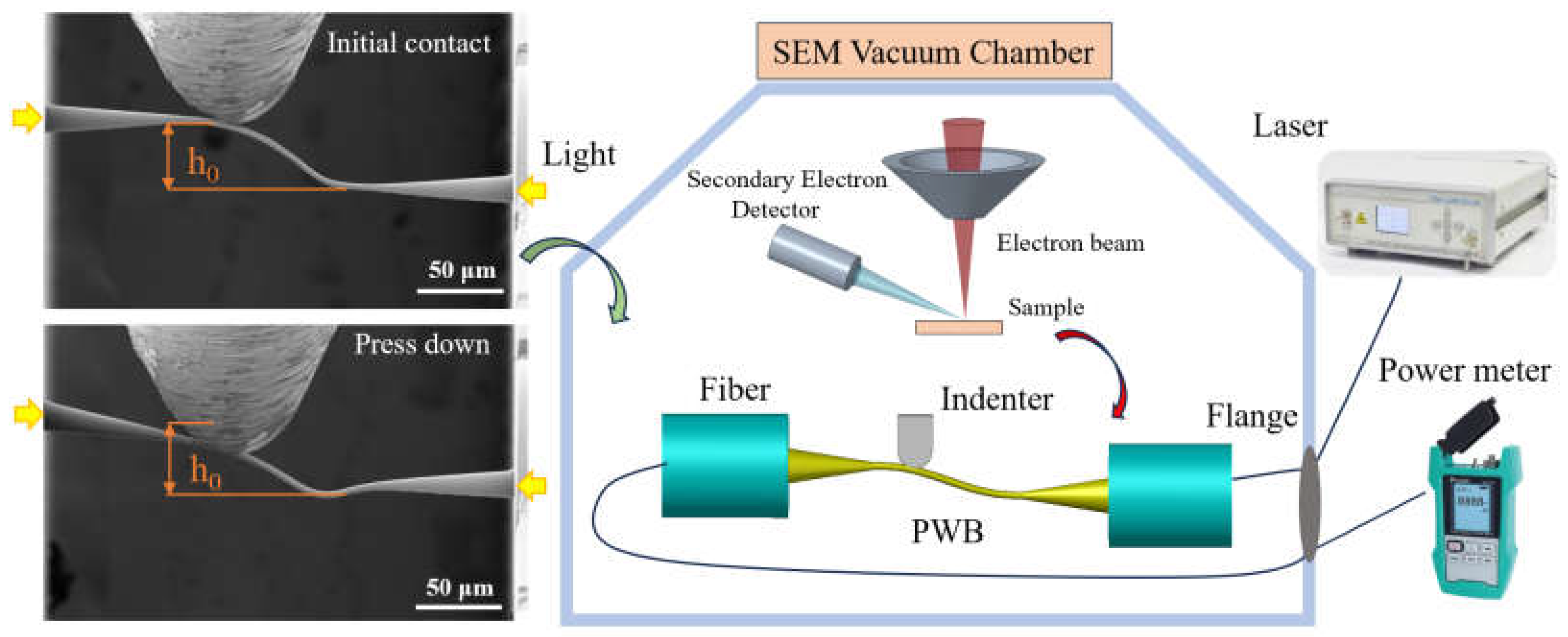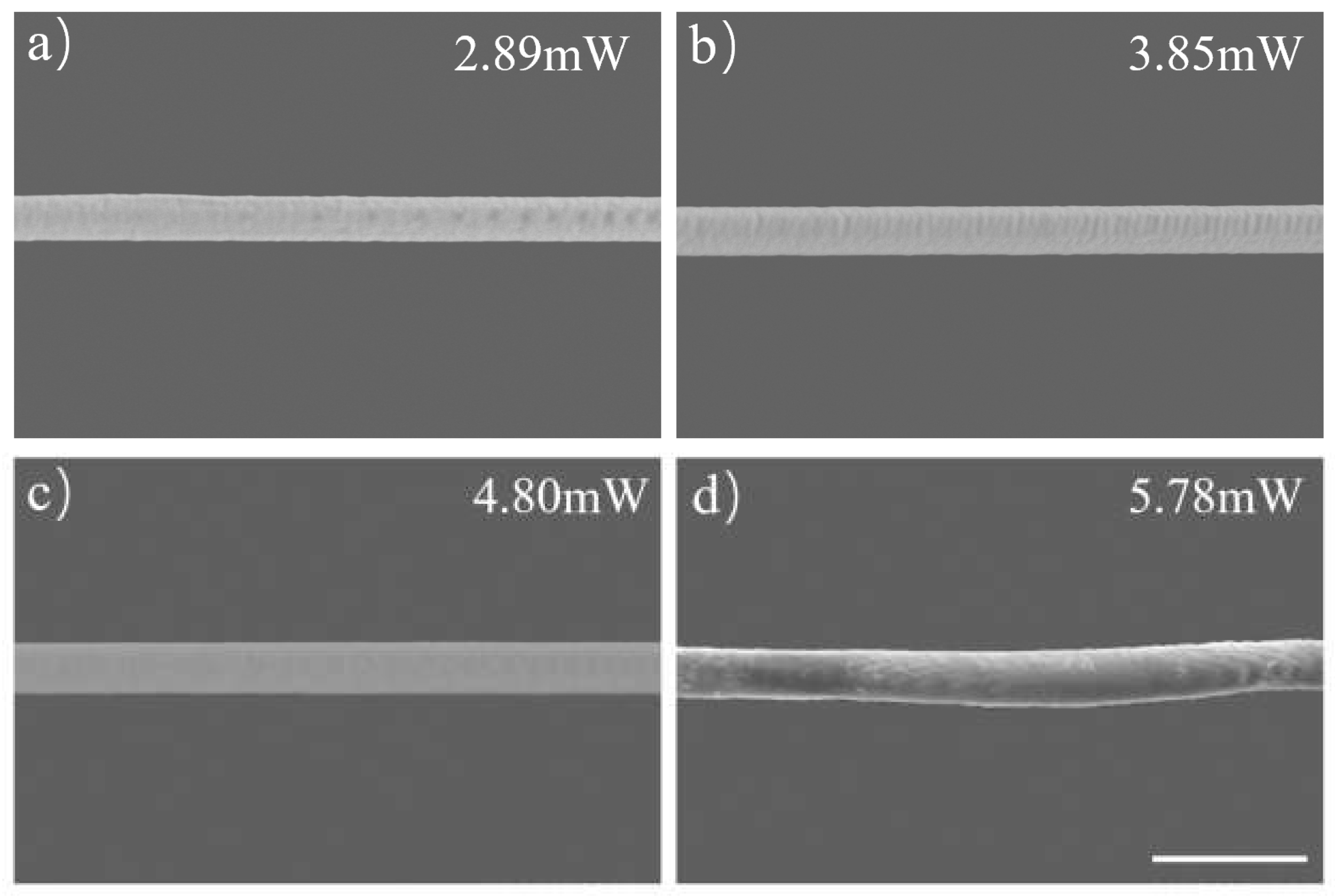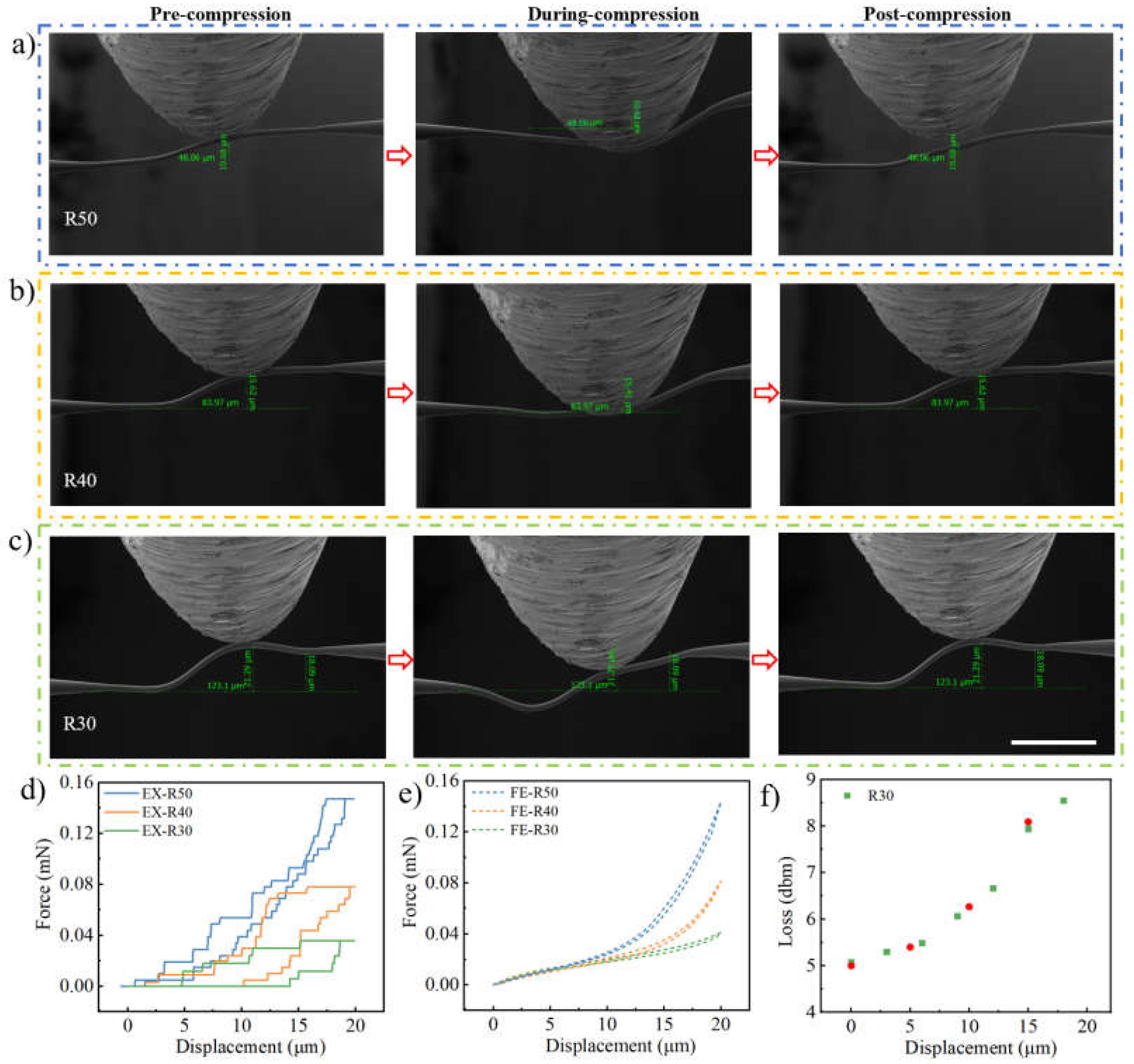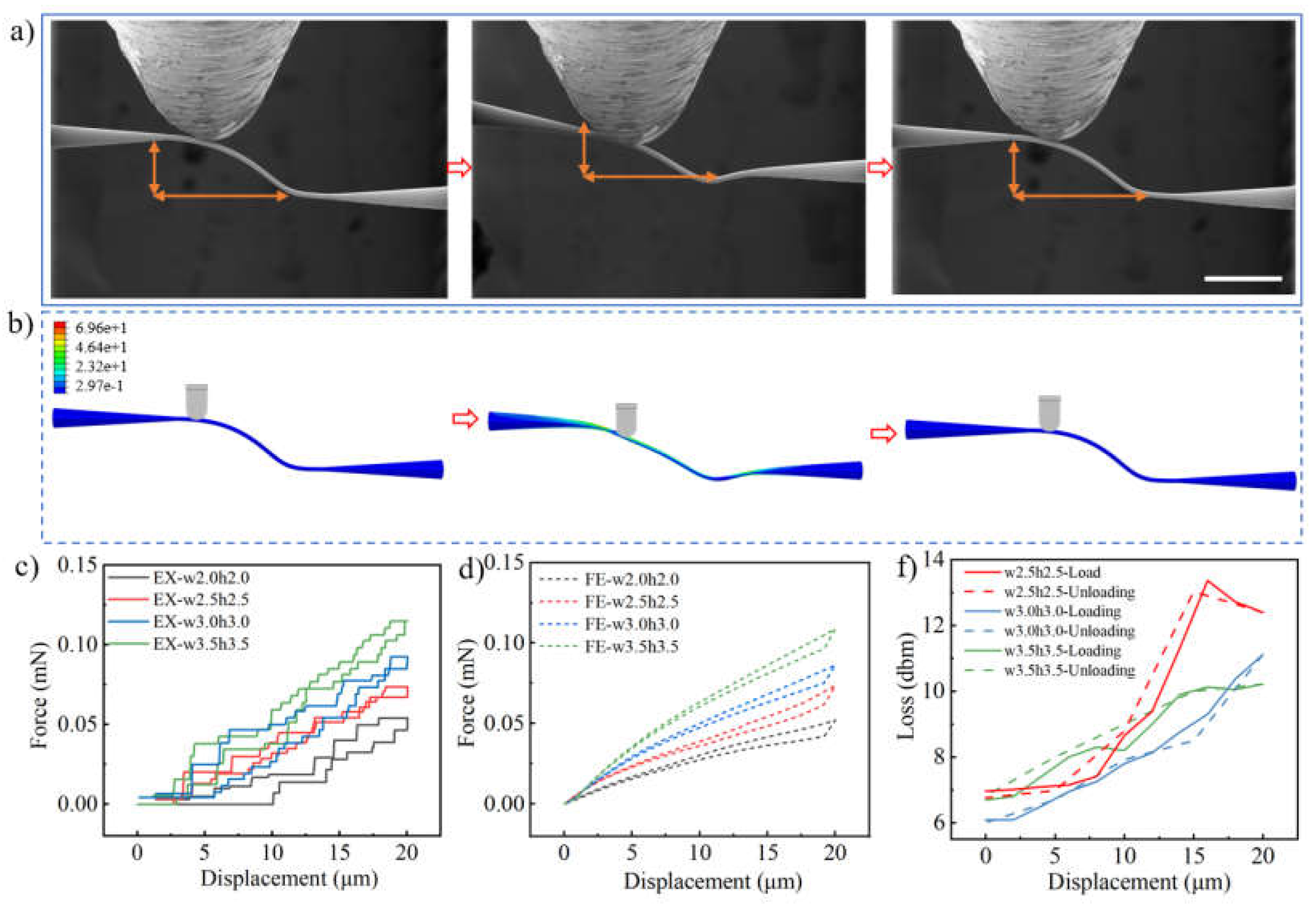Submitted:
20 September 2024
Posted:
23 September 2024
You are already at the latest version
Abstract
Keywords:
1. Introduction
2. Materials and Methods
2.1. Materials
2.2. PWB Fabrication and Characterization
2.3. FEM Simulation
3. Results and Discussion
3.1. In-Situ Multiphysical Metrology
3.2. Laser Parameters of PWB by TPP.
3.3. Geometrical Design for Low-Loss PWB
3.4. Mechanical Resilience and Optical Recovery of PWB
4. Conclusions
Supplementary Materials
Author Contributions
Funding
References
- Florea, L.; Blasco, E.; Mattoli, V. , New Frontiers in Materials and Technologies for 3D Two Photon Polymerization. Advanced Functional Materials 2023, 33(39), 2305697. [Google Scholar] [CrossRef]
- Schwärzle, D.; Hou, X.; Prucker, O.; Rühe, J. , Polymer Microstructures through Two-Photon Crosslinking. Advanced Materials 2017, 29(39), 1703469. [Google Scholar] [CrossRef] [PubMed]
- Bauer, J.; Guell Izard, A.; Zhang, Y.; Baldacchini, T.; Valdevit, L. , Programmable Mechanical Properties of Two-Photon Polymerized Materials: From Nanowires to Bulk. Advanced Materials Technologies 2019, 4(9), 1900146. [Google Scholar] [CrossRef]
- Chu, W.; Tan, Y.; Wang, P.; Xu, J.; Li, W.; Qi, J.; Cheng, Y. , Centimeter-Height 3D Printing with Femtosecond Laser Two-Photon Polymerization. Advanced Materials Technologies 2018, 3(5), 1700396. [Google Scholar] [CrossRef]
- Henning, I.; Woodward, A. W.; Rance, G. A.; Paul, B. T.; Wildman, R. D.; Irvine, D. J.; Moore, J. C. , A Click Chemistry Strategy for the Synthesis of Efficient Photoinitiators for Two-Photon Polymerization. Advanced Functional Materials 2020, 30(50), 2006108. [Google Scholar] [CrossRef]
- Han, F.; Gu, S.; Klimas, A.; Zhao, N.; Zhao, Y.; Chen, S.-C. , Three-dimensional nanofabrication via ultrafast laser patterning and kinetically regulated material assembly. Science 2022, 378(6626), 1325–1331. [Google Scholar] [CrossRef]
- Burmeister, F.; Zeitner, U. D.; Nolte, S.; Tünnermann, A. , High numerical aperture hybrid optics for two-photon polymerization. Opt. Express 2012, 20(7), 7994–8005. [Google Scholar] [CrossRef]
- Pudis, D.; Goraus, M.; Urbancova, P. , Optical properties of woodpile structures for application on the surface of photonic devices. Applied Surface Science 2018, 461, 227–232. [Google Scholar] [CrossRef]
- Yao, P.; Liu, R.; Broggini, T.; Thunemann, M.; Kleinfeld, D. , Construction and use of an adaptive optics two-photon microscope with direct wavefront sensing. Nature Protocols 2023, 18(12), 3732–3766. [Google Scholar] [CrossRef]
- Billah, M. R.; Blaicher, M.; Hoose, T.; Dietrich, P.-I.; Marin-Palomo, P.; Lindenmann, N.; Nesic, A.; Hofmann, A.; Troppenz, U.; Moehrle, M.; Randel, S.; Freude, W.; Koos, C. J. O. , Hybrid integration of silicon photonics circuits and InP lasers by photonic wire bonding. Optica 2018, 5(7), 876–883. [Google Scholar] [CrossRef]
- Lin, B.; Witt, D.; Young, J. F.; Chrostowski, L. , Cryogenic optical packaging using photonic wire bonds. APL Photonics 2023, 8(12), 126109. [Google Scholar] [CrossRef]
- Cai, C.; Wang, J. , Femtosecond Laser-Fabricated Photonic Chips for Optical Communications: A Review. Micromachines 2022, 13, 630. [Google Scholar] [CrossRef] [PubMed]
- Juodkazis, S., Laser polymerized photonic wire bonds approach 1 Tbit/s data rates. Light: Science & Applications 2020, 9 (1), 72.
- Blaicher, M.; Billah, M. R.; Kemal, J.; Hoose, T.; Marin-Palomo, P.; Hofmann, A.; Kutuvantavida, Y.; Kieninger, C.; Dietrich, P.-I.; Lauermann, M.; Wolf, S.; Troppenz, U.; Moehrle, M.; Merget, F.; Skacel, S.; Witzens, J.; Randel, S.; Freude, W.; Koos, C., Hybrid multi-chip assembly of optical communication engines by in situ 3D nano-lithography. Light: Science & Applications 2020, 9 (1), 71.
- Kiefer, P.; Hahn, V.; Nardi, M.; Yang, L.; Blasco, E.; Barner-Kowollik, C.; Wegener, M. , Sensitive Photoresists for Rapid Multiphoton 3D Laser Micro- and Nanoprinting. Advanced Optical Materials 2020, 8(19), 2000895. [Google Scholar] [CrossRef]
- Lindenmann, N.; Balthasar, G.; Hillerkuss, D.; Schmogrow, R.; Jordan, M.; Leuthold, J.; Freude, W.; Koos, C. , Photonic wire bonding: a novel concept for chip-scale interconnects. Opt. Express 2012, 20(16), 17667–17677. [Google Scholar] [CrossRef]
- Gu, Z.; Amemiya, T.; Ishikawa, A.; Atsumi, Y.; Arai, S. J. J. o. L. M. , Investigation of Optical Interconnection by using Photonic Wire Bonding. Journal of Laser Micro 2014, 10(2), 148–153. [Google Scholar] [CrossRef]
- Liang, Y.; Luo, A.; Wang, L.; Hu, S.; Guo, W.; Yao, Y.; Wan, Q. , In-situ SEM investigation of low-cycle fatigue behavior and microstructure evolution of CoCrNi medium entropy alloy. Journal of Materials Research and Technology 2023, 25, 1–12. [Google Scholar] [CrossRef]
- Barrios, A.; Kunka, C.; Nogan, J.; Hattar, K.; Boyce, B. L. , Automated High-Throughput Fatigue Testing of Freestanding Thin Films. Small Methods 2023, 7(7), 2201591. [Google Scholar] [CrossRef]
- Wang, X.; Zhao, Y.; Wang, L.; Wei, L.; He, J.; Guan, X. , In-situ SEM investigation and modeling of small crack growth behavior of additively manufactured titanium alloy. International Journal of Fatigue 2021, 149, 106303. [Google Scholar] [CrossRef]
- Juri, A. Z.; Basak, A. K.; Yin, L. , In-situ SEM micropillar compression of porous and dense zirconia materials. Journal of the Mechanical Behavior of Biomedical Materials 2022, 132, 105268. [Google Scholar] [CrossRef]
- Chen, B.; Yang, R.; Dong, J.; Wang, S.; Wang, J.; Huan, Y. , Development of in-situ SEM torsion tester for microscale materials. Measurement 2019, 139, 421–425. [Google Scholar] [CrossRef]
- Fritz, R.; Kiener, D. , Development and application of a heated in-situ SEM micro-testing device. Measurement 2017, 110, 356–366. [Google Scholar] [CrossRef]
- Cherukuri, R.; Lambai, A.; Sukki, L.; Väliaho, J.; Kallio, P.; Sarlin, E.; Ramachandramoorthy, R.; Kanerva, M.; Mohanty, G. , In-situ SEM micropillar compression and nanoindentation testing of SU-8 polymer up to 1000 s−1 strain rate. Materials Letters 2024, 358, 135824. [Google Scholar] [CrossRef]
- Rohbeck, N.; Ramachandramoorthy, R.; Casari, D.; Schürch, P.; Edwards, T. E. J.; Schilinsky, L.; Philippe, L.; Schwiedrzik, J.; Michler, J. , Effect of high strain rates and temperature on the micromechanical properties of 3D-printed polymer structures made by two-photon lithography. Materials & Design 2020, 195, 108977. [Google Scholar]
- Li, Q.; Kulikowski, J.; Doan, D.; Tertuliano, O. A.; Zeman, C. J.; Wang, M. M.; Schatz, G. C.; Gu, X. W. J. S., Mechanical nanolattices printed using nanocluster-based photoresists. Science (New York, N.Y.) 2022, 378 (6621), 768-773.
- Bauer, J.; Schroer, A.; Schwaiger, R.; Kraft, O. , Approaching theoretical strength in glassy carbon nanolattices. Nature Materials 2016, 15(4), 438–443. [Google Scholar] [CrossRef] [PubMed]
- Vlasov, Y. A.; McNab, S. J. , Losses in single-mode silicon-on-insulator strip waveguides and bends. Opt. Express 2004, 12(8), 1622–1631. [Google Scholar] [CrossRef]
- Park, J.-G.; Lee, S.-H.; Ryu, J.-S.; Hong, Y.-K.; Kim, T.-G.; Busnaina, A. , Interfacial and Electrokinetic Characterization of IPA Solutions Related to Semiconductor Wafer Drying and Cleaning. Journal of The Electrochemical Society 2006, 153(9), G811–G814. [Google Scholar] [CrossRef]





Disclaimer/Publisher’s Note: The statements, opinions and data contained in all publications are solely those of the individual author(s) and contributor(s) and not of MDPI and/or the editor(s). MDPI and/or the editor(s) disclaim responsibility for any injury to people or property resulting from any ideas, methods, instructions or products referred to in the content. |
© 2024 by the authors. Licensee MDPI, Basel, Switzerland. This article is an open access article distributed under the terms and conditions of the Creative Commons Attribution (CC BY) license (http://creativecommons.org/licenses/by/4.0/).




